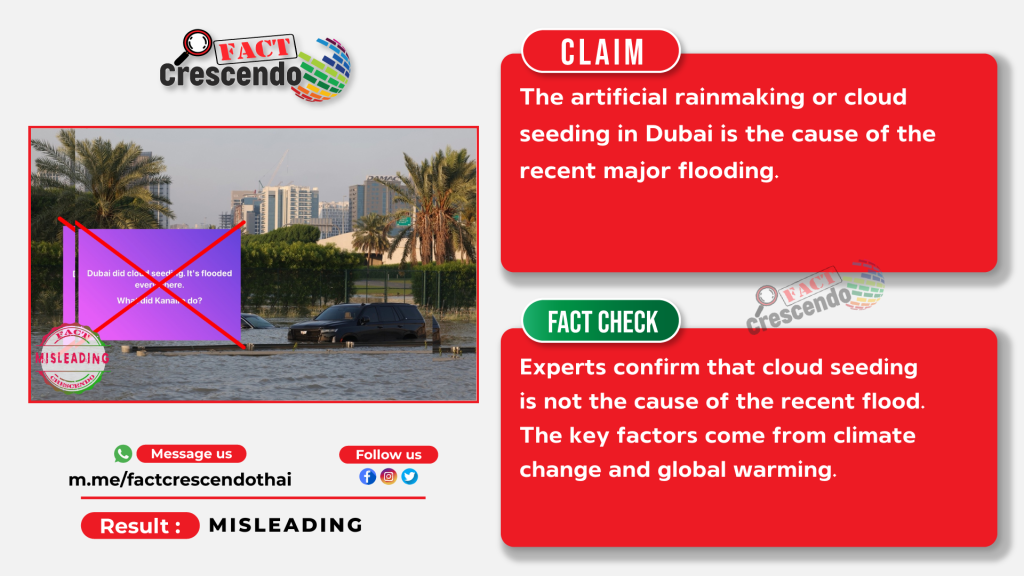
Recently, Dubai experienced its most significant rainfall in 75 years, resulting in extensive flooding and disruption. Following these events, many social media posts have surfaced attributing the floods to the city’s cloud seeding operations.
Social Media Claims
Recently, several Facebook users posted messages attributing the major flooding in Dubai to the city’s cloud seeding project.



Fact-Check
The National Center of Meteorology (NCM), which is in charge of the Cloud Seeding project in the United Arab Emirates, informed CNBC that it did not perform cloud seeding before or during the weather anomalies.
Maarten Ambaum, a Professor of Physics and Meteorology at the University of Reading, stated that he spoke with meteorologists at the NCM. They denied conducting cloud seeding during the specified period. He further clarified that in the Emirates, cloud seeding is typically applied to clouds that do not produce rain, thus it wouldn’t cause heavy rainfall. Applying cloud seeding to clouds already likely to produce heavy rain would not be beneficial (Source).
Several experts posit that the rainfall’s origin is related to a substantial storm system that moved through the Arabian Peninsula and crossed the Gulf of Oman, also resulting in abnormal humidity conditions in neighboring countries like Oman and southeastern Iran.
Colin McCarthy, a geoscientist, attributed the heavy rain to several intense thunderstorms that formed from the warm water in the Persian Gulf.
Climate change is another cause. Friederike Otto, a meteorologist, informed AFP that there is a high likelihood that the heavy rains which devastated Oman and Dubai will intensify due to human-induced climate change (Source).
How does Cloud Seeding work?
Cloud seeding fundamentally works by mimicking the natural processes of rain and snow formation. In standard cloud conditions, tiny water droplets in steam are drawn to particles floating in the atmosphere, such as dust, flower pollen, or sea salt. When enough water droplets gather around a nucleus, they form ice crystals and descend.
Usually, cloud seeding employs aircraft equipped with special gear, but ground-based generators are also used. This process involves injecting particles, typically Silver Iodide, into and around selected clouds to serve as a nucleus and stimulate precipitation. (Source)
Cloud Seeding Controversies
The process of cloud seeding has been a contentious issue for a long time. Its proponents highlight its effectiveness, referencing studies that indicate a 10-15% increase in precipitation. On the other hand, critics warn of potential hazards to public safety and the environment, urging caution. Over the years, research has led to the development of static and dynamic seeding techniques, which showed encouraging results towards the end of the 20th century.
While cloud seeding presents a potential solution for areas grappling with water shortages, its success is far from assured. Indeed, pinpointing extreme weather phenomena to specific interventions, such as cloud seeding, is fraught with complexities. This underlines the necessity for continued research and a deeper understanding of this technology.
Read More: What is Cloud Seeding? Was it responsible for the Dubai floods?
Summary
The claim circulating on social media that Dubai’s cloud seeding project caused recent major floods is incorrect. Experts and the National Center of Meteorology (NCM) assert that cloud seeding cannot lead to such heavy rainfall. This erratic weather condition is primarily due to climate change and global warming.
Follow us and stay up to date with our latest fact checks.
Facebook | Twitter | Instagram | LINE | TikTok | WhatsApp

Title:Is Cloud Seeding to Blame for Recent Dubai Floods?
Fact Check By: Cielito WangResult: Misleading




